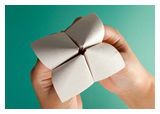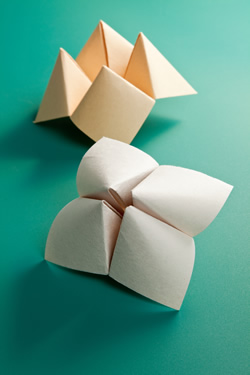|
 Mastering the difference in use between will and be going to for discussing future predictions can be confusing for students. Celce-Murcia and Larsen-Freeman (1999) state the difference between these two forms relates to their meanings, with will referring to spontaneous decisions and be going to for premeditated decisions. One solution to clarify this is through a 40-minute interactive lesson in which students create “fortune tellers” (sometimes called “cootie catchers”) to make four predictions using will (e.g., You will meet a woman) and four predictions using be going to (e.g., You are going are going to meet a woman). Mastering the difference in use between will and be going to for discussing future predictions can be confusing for students. Celce-Murcia and Larsen-Freeman (1999) state the difference between these two forms relates to their meanings, with will referring to spontaneous decisions and be going to for premeditated decisions. One solution to clarify this is through a 40-minute interactive lesson in which students create “fortune tellers” (sometimes called “cootie catchers”) to make four predictions using will (e.g., You will meet a woman) and four predictions using be going to (e.g., You are going are going to meet a woman).
Materials
- Square pieces of paper for each student
- Instructions for making the fortune teller
- List of sample prediction sentences (Appendix [.docx])
Procedure
1. Students Make a Fortune Teller (5–10 minutes)
Lead the students in the process of making a fortune teller:
- Take a square piece of paper. Fold the paper diagonally in half both ways, and reopen to original size.
- Fold corners into the center.
- Turn the folded paper (now a smaller square) over, and again fold the corners into the center.
- Fold the paper in half, lengthwise, in both directions.
- Insert you fingers under the four out tabs and push them up toward the middle, creating a point with your fingers and causing the flaps to stand out on their own.
- Label the fortune teller:
- Section 1. Label the four outer tabs 1–4.
- Section 2. Label the inside tabs 1–8.
- Section 3. The innermost tabs should have eight different predictions written under them.
(You can also go to Wikipedia for instructions with images.) Guiding the students through the steps to make the fortune tellers with a sample finished product to show in class works best. Students need crisp folds to make it easier to use the fortune teller in the final activity. (Some students may already be familiar with fortune tellers and may be able to help other students with folding.)
Once the folding is completed, guide the students in numbering their fortune tellers. They should number the four outer flaps (1–4) and the eight inner triangles (1–8). Refer to the diagrams in the Appendix (6a for the outer flaps and 6b for the inner triangles).
 2. Students Write Predictions (5–10 minutes) 2. Students Write Predictions (5–10 minutes)
Post example sentences (Appendix [.docx]) on a document viewer, computer, or overhead projector. Once the fortune tellers are formed, have students write predictions in their fortune tellers under the eight triangle tabs. Students need time to compose their predictions. They should be only be allowed to use a maximum of four example sentences, thus generating at least four sentences on their own. Monitor the room to ensure that students are writing the predictions in the correct part of the fortune teller.
3. Students Predict the Future (10–15 minutes)
Once everyone has finished composing sentences, demonstrate an interaction with a volunteer.
A: Can you tell me my future?
B: Yes! Pick a number between 1 and 4.
A: Four.
B: [Counts to 4 while holding and moving the fortune teller. At 4, reveals four new numbers between 1 and 8]: Pick a new number.
A: Five.
B: [Counts to 5 while holding and moving the fortune teller, reveals the numbers again]: Choose another number.
A: Three.
B: [Reads the prediction listed under the number three.]
Release the students to circulate the room using the fortune teller to predict the future for their classmates. Showing off their creation and interacting with their classmates solidifies the grammatical structure in a memorable way for students.
4. Recap the Simple Future Tense Forms (10 minutes)
After the interaction, lead the class in a discussion explaining the differences between the use of will and be going to for the formation of simple future statements. The lesson can include examples from the course textbook or explanations on the differences in meaning and usage between the two verb forms. It is useful to have students identify aspects of the tense from their interactions with their peers.
References
Celce-Murcia, M., & Larsen-Freeman, D. (1999). The grammar book: An ESL/EFL teacher’s course (2nd ed.). Independence, KY: Heinle & Heinle.
Anna Karin Roo is a PhD candidate at Washington State University. She earned an MA TESOL degree in 2008 from the University of Washington and has taught English in China, Hong Kong, and the Seattle, Washington, USA area. She has an interest in teaching grammar in memorable ways for students. |